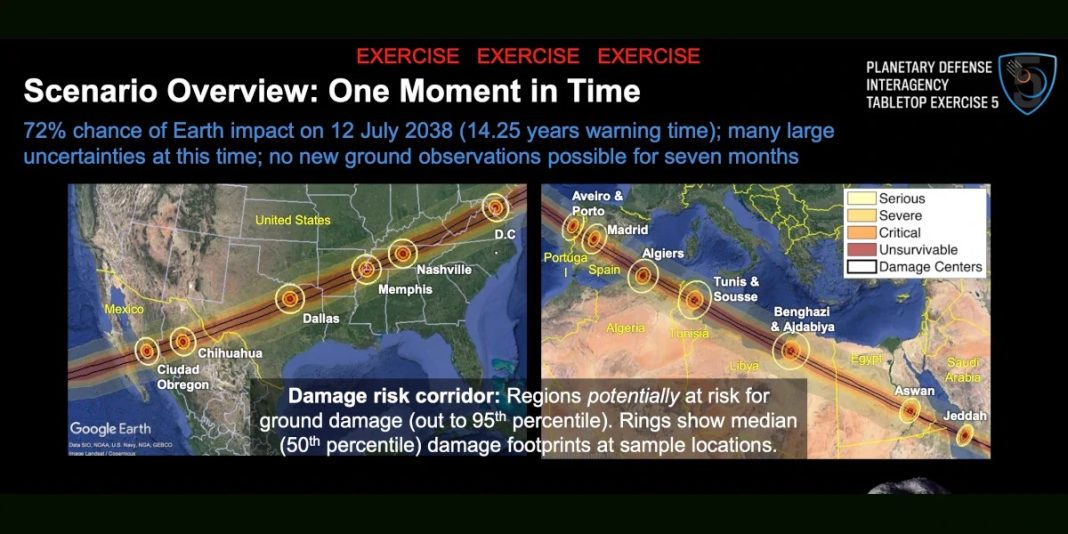Essay by Eric Worrall
Even with a hypothetical 14 year warning, we’re still not ready to deflect dangerous incoming space rocks.
Planetary Defence: Interagency Tabletop Exercise 5
Quick-Look Report
13 May 2024
2-3 April 2024 John Hopkins APL with remote participationExecutive Summary
U.S. interagency exercise sponsored jointly by NASA and FEMA to improve preparedness and planning for an asteroid impact; emphasis on international coordination and collaboration.
Scenario
- 72% chance than an asteroid may hit Earth in 14 years
- Requirements for preventing its impact are unknown
- Models indicate the asteroid could devastate a regional- to country-scale area, if it should impact.
Objectives
- Awareness raising; space mission options; disaster preparedness; information sharing and public messaging.
Participants: Several U.S. agencies and organisations, as well as the UN Office of Outer Space Affairs and international partners.
TTX Takeaways
- 14-year timeline complicates decision making when large uncertainties still exist, which underscores the need for capabilities to obtain better information about the asteroid.
- Clear support for international collaboration at all stages.
Key Gaps
- Decision-making processes and risk tolerance not understood.
- Limited readiness to quickly implement needed space missions
- Timely global coordination of messaging needs attention.
- Asteroid impact disaster management plans are not defined.
Read more: https://www.nasa.gov/wp-content/uploads/2024/06/ttx5-quicklook-report-final.pdf?emrc=66776bee4e06b
The press release is available here.
Russia wasn’t named on the list of international participants. I guess even when it comes to saving the world from a global threat, politics still comes first. I don’t know whether Russia or the Biden Administration was responsible for Russia’s failure to participate.
The hypothetical 14 years of warning postulated by the exercise seems a little on the optimistic side, when it comes to unexpected threats. Certainly there are large rocks which cross Earth’s orbit which are well known threats, such as 101955 Bennu, which might be a threat in the year 2182. But there are also occasional visitors from deep space like ʻOumuamua, the strange cigar shaped large space body which passed through the solar system at 26km / second in 2017. The total period of observation for ʻOumuamua was only 80 days.
In my opinion there is a simple, affordable way to be much better prepared for potential space visitors – build a Project Orion Spaceship, test it a few times, then keep it on ice until needed.
Project Orion is the most capable space launcher we can aspire to build with current levels of technology. The most powerful Orion concept design, Freeman Dyson’s momentum limited Orion, in theory had sufficient Delta-v to power a 133 year mission to Alpha Centauri at 3% of the speed of light after maintaining a 1G acceleration for 10 days, so there would be no shortage of power with this space drive to match orbits with even the fastest and most eccentric inbound space bodies. And most important of all, if all else fails, and Orion ship would have the power to alter the orbit of the space body just by pushing on it. Even a very substantial space body weighing billions of tons could be deflected by an Orion. An Orion could also be constructed with very little of the normal space vehicle weight saving considerations, the process of constructing an Orion would be more like building a large armoured battleship than a traditional chemical powered space launcher.
Detonating a few nuclear bombs in the atmosphere in some remote location to develop such an important new space capability seems a reasonable trade for being ready to save the world from a low probability high impact event which could manifest with very little warning.
Related


